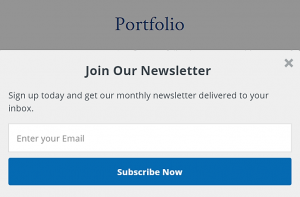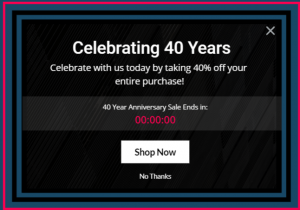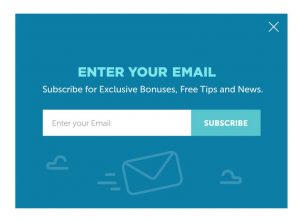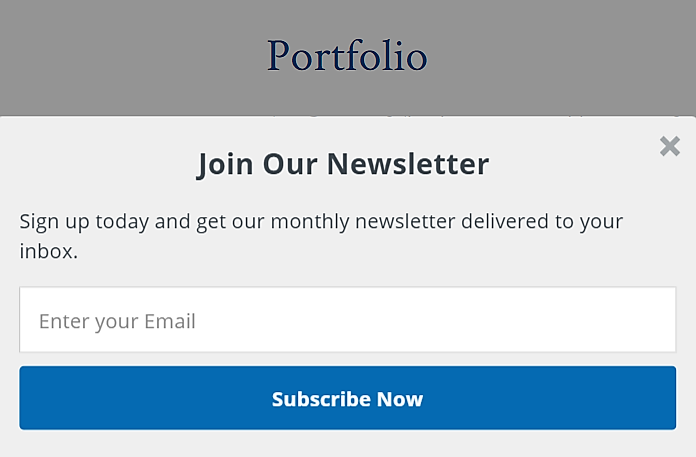
Most of us don’t think favorably of the word pop-up. In fact, today’s browsers come preinstalled with pop-up blockers for those of us who remember the days of blinking “$1,000,000 cash winner!” pop-ups from unsafe websites. If you feel this way, you’re in the majority as 73% of people dislike pop-up ads. With a stigma like that, it’s hard to imagine why professional businesses utilize similar pop-up marketing on their websites. In reality, businesses that use pop-ups see up to a 40% decrease in bounce rate on their website. But there is the other side of the coin. When done correctly, pop-ups offer some opportunities to convert visitors to customers.
Timing
Originally created as an online advertising technique, pop-ups technology has evolved to include a multitude of potential uses. Pop-ups can be timed to appear after a user has spent a pre-determined amount of time on a website. This technique is especially effective with landing pages that have a lot of content, enabling visitors to browse undisturbed until you’re ready to offer your call-to-action. Another type of pop-up is triggered either by entry to a page or at attempted exit. Entry pop-ups can feel invasive but work effectively for exclusive content, timed promotions or special offers. Exit pop-ups are among the most favored in the B2B realm due to their less intrusive nature. Exit pop-ups use “mouse-tracking” to anticipate when a visitor considers leaving your website. A friendly reminder to sign up for your newsletter, attend a webinar or download an ebook can be all it takes to keep your prospect or customer intrigued or informed.

Placement
Just like with timing, placement of your pop-up can result in the subtle difference between an annoying pop-up and a converted lead. A popular placement method is “anchoring.” An anchored pop-up will follow the page even as the user tries to scroll up or down. This encourages a response but can sometimes be perceived as intrusive. Another option is the “scroll pop-up.” This is similar to a timed pop-up but occurs after the user has scrolled down a certain percentage of the page, creating the assumption they are interested in the content. A scroll pop-up can also appear at the bottom of a page, such as at the end of an article, to encourage readers to download a related white paper or ebook.
When it comes to placement, the biggest key is context. If content is king, context is queen. The right context can get conversion rates on your pop-up increased to over 40%. It may seem obvious, but your pop-up should be related to the content of the page on which it is appearing. If your prospect is consuming content, offer them additional related topics or a chance to sign up and receive similar information straight to their inbox. If your prospect is reviewing pricing, it’s effective to implement an exit pop-up that suggests scheduling a call with a rep. Stay relevant and use data analysis to feed off of the needs and interests your prospects’ activity shows.
Messaging
Creating a concise, direct and effective call-to-action for your pop-up is often the hardest part about developing an effective strategy. The smallest subtleties can mean the difference between another click or a bounce. Draw prospects in with your company’s personality and brand. Use numbers and statistics to drive value. Be exclusive with membership benefits or promotional offers. However you choose to do it, the key to helpful messaging is to evoke trust, create a sense of urgency and offer something of value.
Mixed Reviews of Pop-Ups

The use of pop-ups can be tricky for marketers. There’s some degree of risk, especially because they garner mixed reviews from prospects and stakeholders alike. When faced with a statistic like 73% of people dislike pop-up ads, it’s hard to argue. But as with any initiative, it’s not what you do, but how you do it that counts. When utilized properly, pop-ups provide benefits. They encourage interested parties to keep reading, increase subscribers immensely, and provide a value proposition when needed. Don’t be afraid to test the waters. Try a few well-placed, relevant and direct pop-ups, and then determine if it’s a strategy worth keeping.

